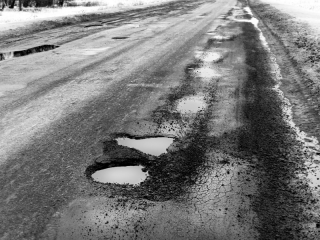
Throughout the winter months, your role as a fleet manager should involve preparing your fleet for driving in adverse weather conditions and managing the wear and tear the colder months leave vehicles vulnerable to. In a survey conducted by a tyre supplier, 54% of respondents said their vehicle had been damaged by poorly maintained roads, which is unsurprising when considering the number of potholes in the roads in the UK.
Local councils in the UK have reported filling in almost 1.7 million potholes in 2021 - this figure equals one pothole being filled every 19 seconds. However, winter roads will bring more dangers to your fleet than just potholes. High winds can blow debris into the road, and salted roads can result in rusted components.
Why do potholes form?
Even though you might encounter potholes all year round, they’re initially created in winter, when it’s cold enough for ice to form. As the ice forms, it travels down through the tarmac into the aggregate below. Once below the tarmac surface and the weather warms, the resulting pool of water begins to disrupt the surface underneath the road, causing it to break apart.
As traffic begins to travel over the road, the ice breaks up further and the aggregate shifts, resulting in a pothole. Some councils will carry out pothole repairs that simply fill the hole with tarmac, however, this is often a temporary fix that will soon break apart once traffic begins travelling over the patches. In addition, further icy weather will quickly make short work of the tarmac plug as the water and ice travel deeper into the ground.
To properly repair potholes in the road, councils have to completely resurface the road, ensuring the pothole is filled correctly, and the tarmac is on top. However, this can be expensive and the resulting delays on the road mean authorities are often reluctant to commit to extensive repairs.
How to tell if a pothole has damaged your vehicle
Potholes are not good for vehicles, so fleet managers should be aware of the dangers potholes can bring and inform your drivers of the hazards. The chaos they cause can range from damaged shock absorbers, broken suspension springs and distorted wheels. Not only this, but potholes can cause vehicles to change direction, veering off in unexpected directions, resulting in road accidents.
Tyres
Some of the more blatant signs of pothole damage are punctures or bulges in the tyre wall. If your vehicle has a tyre bulge after an encounter with a pothole then you should get it sorted straight away. If left alone, tyre bulges can allow air to escape the tyre rapidly, which in turn, may result in a loss of control of the vehicle.
Potholes can also lead to the tread coming away from the main body of the tyre, an issue that will also need to be resolved as soon as possible and will impact a vehicles ability to pass its MOT. The type of tyre you have can also determine the likelihood of damage; low-profile, thinner tyres are more likely to come off worse. More often seen on a sports vehicle, narrower tyres are less well equipped to absorb the impact of a pothole, something your fleets probably won't have to contend with. One way to reduce overall impact damage is to ensure your tyres are properly inflated.
Wheels
Potholes can also wreak havoc on your wheels, bending, chipping, or cracking them. If the cracks are thin, it may be difficult to spot them but washing your wheels should reveal any potential cracks. Once again, these are damages that need to be seen to quickly to reduce putting drivers in danger or causing further damage.
Suspension
Alternatively, if there's damage to the suspension, you may feel that the car is difficult to control. This could mean the car feels unsteady when you turn, bounces a lot, or you may notice vibrations and sounds that weren't there before. If the suspension is knocked, misalignment can occur, leaving the wheels sitting at the wrong angle. You may also find that your car is pulling to one side or that the tyres are unevenly worn.
Other common indications of pothole damage include leaking fluids, damage to the car's underside or unusual noises coming from the exhaust. All of which will need to be addressed reasonably quickly.
Debris on the road
Winter often brings high winds and storms, resulting in additional debris on the roads. While easier to remove and only likely to cause damage in the colder months, debris is no less dangerous than a road full of potholes.
Rural and quieter roads can see their fair share of mud, branches, and other blockages in the road, making things difficult for your fleet's drivers. Most commonly an issue in more rural areas, mud on the road presents a risk of skidding, especially in freezing conditions. If poor weather conditions are also present then drivers' visibility may be reduced, increasing the likelihood of not spotting blockages on the road.Highways England has stated that most road incidents were the result of debris from damaged vehicles, something drivers should be vigilant for at any time of year.
How to drive on poorly maintained roads
Driving safely and responsibly should be done at all times, but when driving on poorly maintained roads, your fleet can benefit from an additional level of care. While the most straightforward solution at first may be to avoid obstructions by driving around them, this isn't always possible. This can be especially challenging when driving conditions leave your drivers, quite literally in the dark or with poor visibility.
If it’s safe to do so, slowing down can be a successful way of reducing the impact of a pothole and can make it easier to navigate roads filled with obstacles. It's also wise to remind your drivers to maintain a distance between themselves and the vehicle in front of them so that they can keep an eye out for any rough surfaces.Similarly, puddles can often be deceptive when it comes to hiding deeper holes.
As discussed above, potholes are often formed by pooling water, so if avoidable they should be driven around. Ultimately, if a road is known to be poorly kept, it's often wiser to instruct drivers to find an alternative route. While this may take more time, it can save you money on repairs in the long run.




